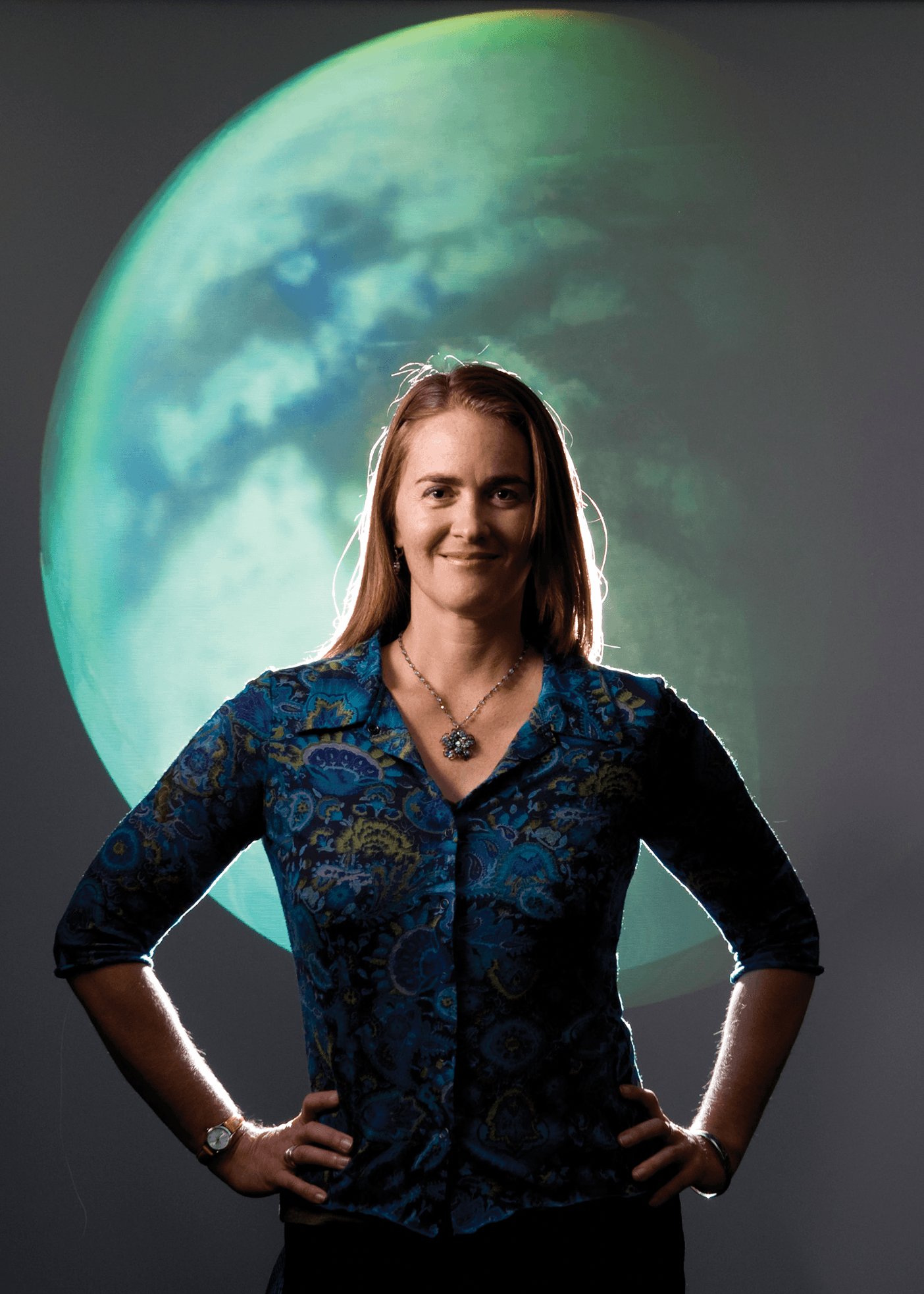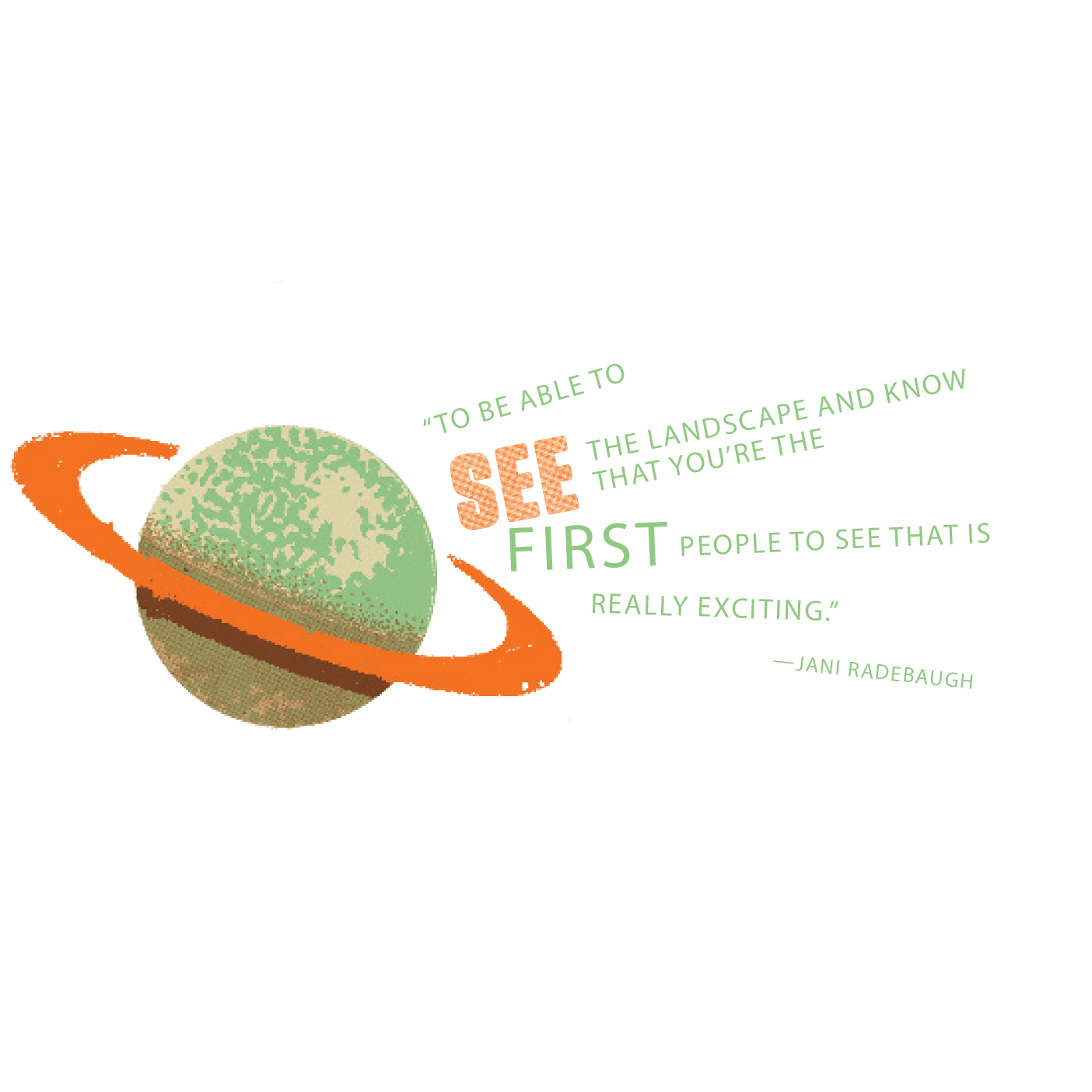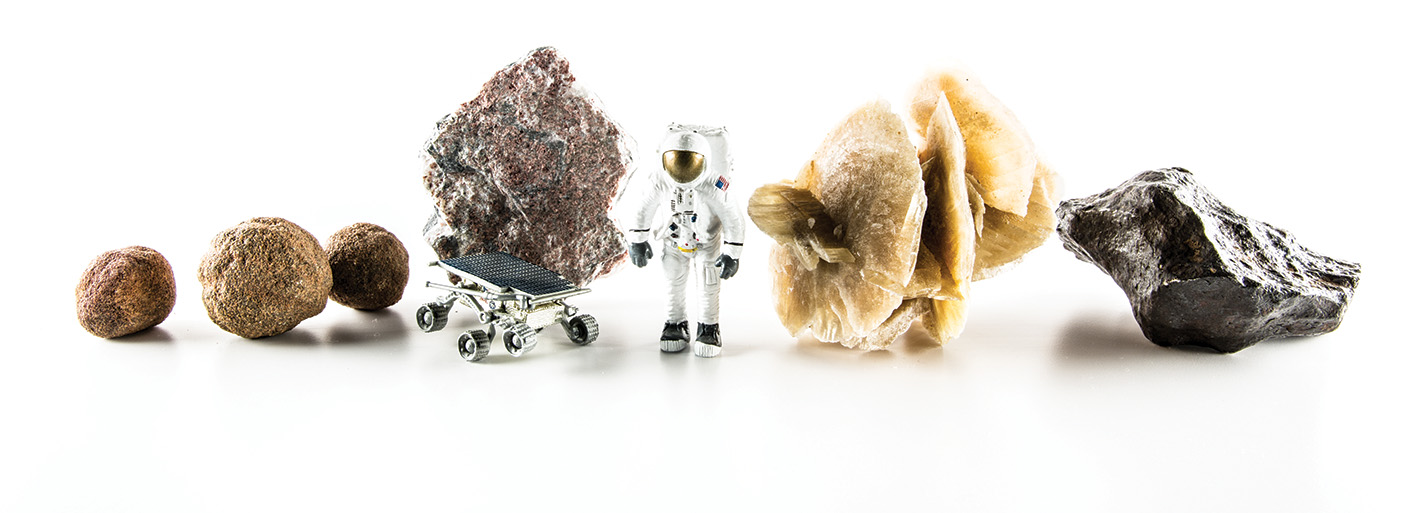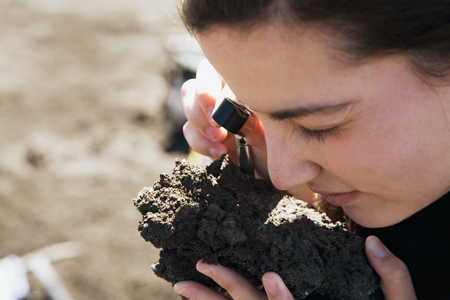Between Heaven and Earth

Dirt under her fingernails and stars in her eyes, planetary geologist Jani Radebaugh is drawn to Earth’s edges.
By Andrea Ludlow Christensen (BA ’03, MA ’05) in the Winter 2016 Issue
Illustration by Peter O’Toole
The soles of her shoes were getting hot. It was Jani Radebaugh’s (BS ’93, MS ’99) first field trip as a geology master’s student at BYU. As she hiked up the pewter-colored mounds of Kilauea, Hawaii’s largest and most active volcano, she heard what sounded like the faint tinkling of glass between gusts of wind. Then, out of the corner of her eye, she caught a glimpse of something moving. In the daylight, she could barely make out the creeping lobe’s glimmer, but she knew just what it was: lava—“baby land . . . being created.” And she fell in love. “I was hooked.”
Radebaugh, now an associate professor of geology at BYU, has since studied land infant and aged on every continent, but she says her favorite site remains Kilauea. Something about the glow of the lava, the radiating heat, the smell of sulfur.
“You feel so vulnerable,” she says. “We’re just fragile little people when it comes to Mother Nature.”
Radebaugh is captivated by the beauty of desolation: ashy lava flows—part black and glassy, part fiery and luminous; wind-carved sand dunes, up to 75 stories high, towering ridges in a searing desert; expansive sheets of blue ice, broken by peaks of white. In her favorite places, life is rare, temperatures extreme. And the wind—there always seems to be wind—either blasts like a furnace or stings like a slap in the face.
“There are a lot of things that remind you [that] this is not where people live,” Radebaugh says. “[People] stay away from the deep, empty deserts and they stay away from the tops of the volcanoes and they stay away from the cold glaciers.”
And yet, she feels a pull: “I don’t . . . fully understand why.”
Some of it she attributes to her passion for adventure and discovery—of things below and above. She once dreamed of suiting up for NASA. Now, as the principal investigator on multiple NASA grants and as an associate member of NASA’s Cassini Radar Science team, she analyzes images of Earth-like bodies across the solar system to better understand terra firma; to better understand the heavens, she travels to the farthest reaches of the Earth.
In her office, surrounded by paintings and prints of celestial bodies, as well as hundreds of rocks and sand-filled jars from her travels, she reflects: “Those are places that . . . have really unique [geologic] processes going on. Someone needs to stand on the edge and witness that.”

Dirt on Her Boots, Stars in Her Eyes
When Jani was in first grade, her Pennsylvania school did IQ testing. Soon after, Jani’s mom, Tanya Hale Radebaugh (BS ’68), met with the teacher, who told her, “You have a really intelligent girl here. She could be the president of the United States, or she could get in a lot of trouble—it could go either way.”
Busy and strong willed, Jani could be a handful, say her parents. At church she was fidgety, and she kept herself occupied by roughhousing with her five younger siblings. “We thought for sure we’d never be able to go to church all at the same time,” says her dad, Lee H. Radebaugh (BS ’68).
And she was unfiltered. Lee and Tanya have a laundry list of the embarrassing things the 4- or 5- or 6-year-old Jani said to the woman in the grocery store line, to the hitchhiker in their car, to the man at church. There was the time when a young Jani heard some neighbor kids swearing. “She said, ‘You’d better stop that—President Kimball wouldn’t like it,’” Tanya recalls. “And they were like, ‘Who’s President Kimball?’”
Despite her teacher’s caution, Jani’s parents say she always had a strong internal compass. Lee remembers often coming home from work and seeing Jani sitting with one of her younger brothers or sisters, helping them with homework, giving advice. “I always knew it would be good advice,” he says.
When she wasn’t roughhousing or sharing wisdom, Jani was outside. She remembers sitting in her childhood backyard maple tree for hours, letting her mind wander. And every summer her extended family gathered at Utah’s Capitol Reef National Park, where she and her cousins spent long, hot days running through sand, climbing rocky hills—exploring.
Decades later, just after launching her geology career, Radebaugh hiked through Capitol Reef again. “I looked out over the landscape, and it was all fossil sand dunes—and sitting on top of it were boulders of lava rock,” she says. “It was sitting in front of me the whole time.”

She may not have paid particular attention to the ground as a child, but she remembers distinctly when her eyes turned toward the heavens: age 7. It was family movie night. Star Wars. There was adventure, space travel, and Luke Skyewalker, pensively surveying Tatooine’s binary sunset. “I really identified with [him], in wanting to leave his home and country to go out and do exciting things,” she says.
When Jani eventually landed at BYU, it wasn’t on the U.S. president track but as a physics and astronomy major, pursuing her dream to become an astronaut. Attending a conference at Houston’s Johnson Space Center after earning her bachelor’s, though, she was drawn to the geology-related presentations. So she switched gears and started a BYU master’s program in geology with a focus on planetary sciences.
For the bulk of her still-young career, Radebaugh has studied Io, a colorful volcano-covered moon of Jupiter. She also studies Saturn’s largest moon, Titan, with its myriad surface features, including rivers, lakes, and massive sand dunes.
“She started looking at the stars, then down to the ground, and now she does both,” says Tanya.
Operating at the Fringes
To help her colleagues keep cozy on the holiday, she put her own twist on pemmican, a staple long used by Antarctic explorers. The idea of it, she acknowledges, isn’t exactly appetizing. “But then as you’re chewing it you think, ‘No, that’s got everything I need.’”It was Christmas Day, 2013, and Radebaugh had the perfect gift for her friends and fellow researchers on the Antarctic Search for Meteorites (ANSMET) team: butter-and-bacon-grease-based patties with chopped beef jerky, chocolate, nuts, and berries mixed in. On her third visit to Antarctica—where average December and January temperatures hover around -10 degrees Fahrenheit—she’d come to value dense, calorie-laden food. “You’re constantly burning calories to stay warm when you’re out there, so you always have to be aware of ‘When’s the last time I ate?’”
Working in extreme environments, Radebaugh says, tests the body’s capabilities—and limits. She lectures students and peers on the importance of getting enough sleep, exercise, and calories while out in the field. When a tentmate in Antarctica offered her part of a sandwich, Radebaugh’s response came quick: “I said, ‘Is there a piece of bacon in it? Is there a whole lot of butter? If not, it’s a waste of my time.’”
“We’re operating at the fringes of physical capability,” she says. “You’re pushed to the extreme. You realize, . . . I have to [take care of myself]—there’s no other option.”
Even taking the greatest of care, however, traveling to Earth’s edges is marked by unpredictability and setbacks. Talk to Radebaugh’s colleagues, and they all have stories to tell.
Ralph Lorenz, a lead Titan researcher and regular Radebaugh collaborator, recalls blowing a tire while driving together in the Australian Outback, 200 miles of dirt roads away from the nearest—and still remote—gas station. With the spare, “we limped back to the gas station,” where Radebaugh offered top dollar for a new tire. “I was sort of horrified (and filing my expense report was interesting), but Jani was right—we didn’t have a choice.”

Barbara Cohen, a planetary scientist with the NASA Marshall Space Flight Center, traveled to Antarctica with Radebaugh on the 2013–14 ANSMET team. The two, along with two other colleagues, arrived at their camp as scheduled, but because of equipment troubles, it was nearly a month before the rest of the team—and their meteorite-collection gear—arrived. “There wasn’t much we could do,” says Radebaugh, “so we did what we could.” They decorated their yellow 9-by-9 tents for Christmas, did jumping jacks in the snow, ate chocolate with butter on top (to stay warm, Radebaugh assures), took video of the 50-mph winds pummeling their tents, and rode on snowmobiles, marking meteorites they could later collect.
Cohen remembers feeling too worn out to uncover a field site that had been buried under the snow. Radebaugh encouraged her with a “When are you going to ever do this again? Let’s go do it.” And, says Cohen, “it was totally worth it, of course.”
Antarctica taught Radebaugh the importance of a good attitude. On her first trip out, 60-mph winds blew for nearly a week, and even decked out in her thick snow clothes, boots, and face mask, she never felt entirely warm. “I was kind of distressed about it for a while, and then I realized, I’m uncomfortable now; at some point I won’t be uncomfortable anymore,” she says. “You go to a place in your mind where [the cold is] okay.”
The inconveniences and setbacks only make the payoff sweeter. And there always seems to be a payoff.
Christopher J. Savage (BS ’09, MS ’11) was one of two students who traveled to Egypt with Radebaugh to study dunes in 2010. Because of hang-ups with their permits, they were stuck for nearly two weeks in Cairo, where they waded through crowded sidewalks and hours of traffic to explore what they could: the city. Eventually, the permits came through. And Savage’s payoff? Encountering things he’d never seen before—petrified swamp remains and massive dunes—close to 300 miles long. “Being out in that deep desert, exploring those giant dunes, it was really like being on another planet.”
Sharing the Love
It’s a gleaming gray sphere, brightly lit on the top, with craters large and small on the right, ridges and blue lines snaking like veins on the left.
“Isn’t it so pretty?” Radebaugh asks her geomorphology students, who are among the first to see this photo of Enceladus, one of Saturn’s 62 confirmed moons.
Less than 24 hours earlier, Cassini, the spacecraft orbiting Saturn, flew past Enceladus and sent its captured images 790 million miles back to Earth. So for the first 10 minutes of a class slated for a sand-dune discussion, professor and students break down Enceladus’s distinct features—craters, ridges, cracks—and discuss what they reveal about this particular moon.
Seeing new images of heavenly bodies is an emotional experience for Radebaugh—part reverential awe, part kid-on-Christmas-morning giddiness. She’s had the experience dozens of times as robotic spacecraft Galileo sent back images from Io in the early 2000s, and, more recently, as Cassini has sent images of Titan, Enceladus, and other exotic moons of Saturn.
“To be able to see the landscape and know that you’re the first people to see that is really exciting,” she says. “We all understand what a gift it is.”
As a PhD student, Radebaugh began working to understand Io, a stunningly colorful moon, with shades of gold, dots and blotches of black, swirls of white, green, and red—all the result of its volcanic activity. Galileo’s images offered hints at the processes taking place. And so Radebaugh began following the leads on her volcanic explorations, to Hawaii, Vanuatu, Ethiopia, and more.

Comparing temperatures and other features of volcanoes on Earth and Io, she and colleagues saw similarities. But, they’ve learned, the lavas on Io are far hotter and far faster to erupt than lavas on Earth. Io features vast lakes of lava, much as scientists believe Earth did billions of years ago. Radebaugh calls Io “a laboratory for an early Earth, . . . right around when life was getting started.” Looking at Io, she says, is “like looking back in time.”
And for Radebaugh, it’s more than that: looking at Io speaks of the divine. “Just the beauty, the complexity, the strong history—that feels like evidence that there’s a Creator.”
Studies of Io helped launch Radebaugh’s career, but Galileo’s 2003 plunge into Jupiter’s atmosphere certainly didn’t halt it. With ANSMET, she’s gathered hundreds of meteorites for the United States’ national collection. And with help from Cassini’s images and various grants, including two from NASA’s Outer Planets Research program, she’s explored Titan’s dunes, mountains, lakes, winds, and climate.
It’s been more than a decade since Cassini dropped a probe through Titan’s deep haze down to its surface. The images sent back revealed features that make the moon “one of the most Earth-like worlds we have found to date,” according to NASA’s Jet Propulsion Laboratory. Radebaugh has explored Titan’s mountains (unusual for such an icy body), formed by tectonics similar to those found on Earth. She’s also examined Titan’s atmosphere, thick with methane and a surface pressure similar to Earth’s. The methane forms into clouds, leading to methane rain, rivers, lakes, and seas. (The Cassini team’s 2007 article providing evidence of Titan’s lakes made the cover of Nature). Finally, she’s researched Titan’s massive dunes, which offer proof of active winds on Titan’s surface.
Her research findings show that Titan “isn’t just a static body; it’s active,” Radebaugh says. “We want to be able to understand where else in the solar system life may have gotten started, and Titan is a really good candidate.”
In studying such a broad array of features throughout the solar system, Radebaugh hasn’t swapped breadth for depth, says Jeffrey D. Keith (BS ’77), a BYU geology professor who has collaborated with her on various projects. “She has such a wide-ranging set of interests, and she’s capable in all areas,” he says. “Very few people can make that jump and be an expert on every topic.”
Alexandra A. Ahern (BS ’13), a geology master’s student, researches Io’s tectonics with Radebaugh. “I’m continually surprised at how much she’s involved in,” Ahern says. “Any time I go to a conference, she’s everyone’s favorite—they all know her because she’s so involved in so many different things.”
Cohen, who rooms with Radebaugh each year at the Lunar and Planetary Science Conference, says, “People look forward to having her at conferences, and part of that is her depth of knowledge about geomorphology.” The other part? “Uniformly, people appreciate her positivity,” Cohen notes. “Sometimes as scientists, with funding issues and competing priorities, it’s very easy to sit around and get mopey, and Jani doesn’t do that—it’s not her personality.”
That personality, for Cohen, is encapsulated in memories of shared field trips during their time as PhD students at the University of Arizona. She remembers Radebaugh “on the rocks all the time, scrambling around, standing in a superman pose up on a cliff. . . . Always saying, ‘Let’s get up close, let’s put our hands on, let’s climb up here, let’s walk over there.’ And taking people with her. . . . She’s so charismatic that you just want to go with her and learn from her.”
It’s an enthusiasm she shares with her family, too. Her nieces and nephews all have rock collections in their bedrooms, mementos from Aunt Jani’s world travels. And Melanie Radebaugh Peterson (BS ’03), Radebaugh’s sister, tells of a recent family day hike in Capitol Reef. The sun blazed, and with a half-hour still to go, the tired kids began complaining. But Radebaugh stopped to pick up a rock, started explaining its features to the kids, and eventually distracted them enough so that they were able to finish the hike. “The grandkids are just enamored with her,” Peterson says. “She makes science fun, attainable, inspiring.”

The Open Road
Cassini, which has provided images for much of Radebaugh’s Titan research over the past decade, is scheduled to burn up in Saturn’s atmosphere in 2017. So she is looking ahead, considering possibilities for research on Venus, Mars, Earth’s own moon, and more. “There are so many unique things we’ve found out about our neighbors in the solar system, and there are so many more unique things we need to find out,” she says.
And she plans to continue her explorations of her home planet. Though political and social upheaval present challenges, sand dunes in Yemen and desert landforms in Iran beckon. As do craters and dunes in western Australia, deserts in China, and jungles in Southeast Asia.
Explaining the pull, she reflects on a quote from Carl Sagan’s The Pale Blue Dot: “We were wanderers from the beginning,” he writes. Millennia later, “the sedentary life has left us edgy, unfulfilled. Even after 400 generations in villages and cities, we haven’t forgotten. The open road still softly calls, like a nearly forgotten song of childhood.”
“That describes who I am in many ways, what I’ve been heading toward for a really long time,” she says, tearing up.
Driven by that open road, by her passion for discovery, by the beauty she sees in Earth’s edges, she’ll explore. “We understand the area around us pretty well,” she says, “but then to go somewhere so unique, like the deep desert of the Empty Quarter of the Arabian Peninsula, or the edge of a lake of lava on Vanuatu—that’s just . . . so precious to be able to do that.”
Feedback: Send comments on this article to magazine@byu.edu.




